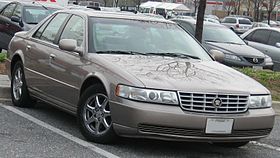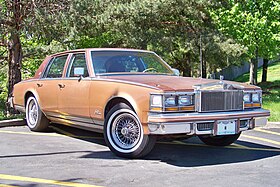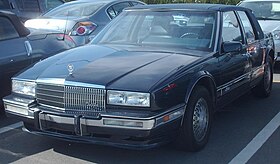Cadillac Seville
| Cadillac Seville | |
|---|---|
 |
|
| Overview | |
| Manufacturer | Cadillac (General Motors) |
| Production | 1975–2004 |
| Body and chassis | |
| Class | Mid-size luxury car |
| Chronology | |
| Successor | Cadillac STS |
| First generation | |
|---|---|
 |
|
| Overview | |
| Also called | Cadillac Civil (Iran) |
| Production | 1975–1979 |
| Model years | 1976–1979 |
| Assembly |
Detroit, Michigan, United States Iran 1977–1987 by Pars Khodro |
| Designer | Bill Mitchell |
| Body and chassis | |
| Body style | 4-door sedan |
| Layout | FR layout |
| Platform | K-body |
| Powertrain | |
| Engine | 350 cu in (5.7 L) Oldsmobile V8 350 cu in (5.7 L) Oldsmobile diesel V8 |
| Transmission | 3-speed automatic |
| Dimensions | |
| Wheelbase | 114.3 in (2,900 mm) |
| Length | 204.0 in (5,180 mm) |
| Width | 71.8 in (1,820 mm) |
| Height | 1975–77: 54.7 in (1,390 mm) 1978–79: 54.6 in (1,390 mm) |
| Second generation | |
|---|---|
 |
|
| Overview | |
| Production | 1980–1985 |
| Assembly |
Detroit, Michigan, United States Linden, New Jersey, United States |
| Designer | Bill Mitchell |
| Body and chassis | |
| Body style | 4-door sedan |
| Layout | Longitudinal front-engine, front-wheel drive |
| Platform | K-body |
| Powertrain | |
| Engine | 1980–82: 5.7 L Diesel 105 hp (78 kW) V8 1980–81: 6.0 L 145 hp (108 kW) V8 1983–85: 4.1 L 135 hp (101 kW) V8 1983–85: 5.7 L Diesel 105 hp (78 kW) V8 |
| Transmission | 4-speed automatic |
| Dimensions | |
| Wheelbase | 114.0 in (2,896 mm) |
| Length | 204.8 in (5,202 mm) |
| Width | 1980–82: 71.4 in (1,814 mm) 1983–85: 70.9 in (1,801 mm) |
| Height | 54.3 in (1,379 mm) |
| Third generation | |
|---|---|
 |
|
| Overview | |
| Production | 1986–1991 |
| Assembly | United States: Detroit/Hamtramck Assembly, Hamtramck, Michigan |
| Body and chassis | |
| Body style | 4-door sedan |
| Layout | Transverse front-engine, front-wheel drive |
| Platform | K-body |
| Powertrain | |
| Engine | |
| Transmission | 4-speed automatic |
| Dimensions | |
| Wheelbase | 108.0 in (2,743 mm) |
| Length | 190.8 in (4,846 mm) |
| Width | 1986–89: 70.9 in (1,801 mm) 1990–1991: 72.0 in (1,829 mm) |
| Height | 1986–1990: 53.7 in (1,364 mm) 1991: 53.2 in (1,351 mm) |
| Fourth generation | |
|---|---|
 |
|
| Overview | |
| Production | 1992–1997 |
| Assembly | United States: Detroit/Hamtramck Assembly, Hamtramck, Michigan |
| Designer | Dick Ruzzin (1989) |
| Body and chassis | |
| Body style | 4-door sedan |
| Layout | Transverse front-engine, front-wheel drive |
| Platform | K-body |
| Related |
Cadillac DeVille Buick LeSabre Buick Park Avenue Oldsmobile 98 Oldsmobile Aurora Pontiac Bonneville |
| Powertrain | |
| Engine | 4.9 L 200 hp (150 kW) V8 4.6 L 275 hp (205 kW) V8 4.6 L 300 hp (220 kW) V8 |
| Transmission | 4-speed automatic |
| Dimensions | |
| Wheelbase | 111.0 in (2,819 mm) |
| Length | 204.4 in (5,192 mm) |
| Width | 1992–94: 74.3 in (1,887 mm) 1995–97: 74.2 in (1,885 mm) |
| Height | 54.5 in (1,384 mm) |
| Curb weight | 3900 lb (1673 kg) |
| Fifth generation | |
|---|---|
 |
|
| Overview | |
| Production | 1998–2004 |
| Assembly | United States: Detroit/Hamtramck Assembly, Hamtramck, Michigan |
| Body and chassis | |
| Body style | 4-door sedan |
| Layout | Transverse front-engine, front-wheel drive |
| Platform | G platform |
| Related |
Buick LeSabre Buick Park Avenue Cadillac DeVille Oldsmobile Aurora Pontiac Bonneville |
| Powertrain | |
| Engine | 4.6 L 275 hp (205 kW) V8 4.6 L 300 hp (220 kW) V8 |
| Transmission | 4-speed automatic |
| Dimensions | |
| Wheelbase | 112.2 in (2,850 mm) |
| Length | 201.0 in (5,105 mm) |
| Width | 75.0 in (1,905 mm) |
| Height | SLS: 55.7 in (1,415 mm) STS: 55.4 in (1,407 mm) |
| Curb weight | SLS: 3,970 lb (1,800 kg) STS: 4,001 lb (1,815 kg) |
The Cadillac Seville is a luxury car that was manufactured by Cadillac from 1975 to 2004, as a smaller-sized premium Cadillac. Despite its smaller size, the Seville typically carried the highest price tag among Cadillac's sedan models. It was replaced by the Cadillac STS in 2005.
The name of "Cadillac's first small car" was selected over a revival of LaSalle and the GM design staff's preference, LaScala, primarily because, notes GM Marketing Director Gordon Horsburgh, "It had no negatives." The initial suggestion was in fact the name "Leland", honoring the make's founder, but it was rejected because most buyers wouldn't understand the reference and because Henry Leland had also founded Cadillac's rival, Lincoln.
Hundreds of suggestions were considered, including: Merlette, Sierra, La Mancha, Canterbury, l’Eclipse, Urbana, Le Nouveau, DeIntegro, Medici, Debonair, Berkshire, Caravel, Road America, Concept II, Americus, Leland, Minuet, Camelot, Renaissance, Counselor, and "Se Ville". After painstaking research, LaSalle was the top pick, with St. Moritz a distant second, trailed farther behind by Seville (properly spelled now). A troubled past and difficult pronunciation, respectively, cleared the way for Seville's use.
Seville is a Spanish province and the capital city of that province, renowned for its history and its treasures of art and architecture. The Spanish master painters Diego Velázquez and Bartolomé Esteban Murillo were from Seville. The Seville name first entered use by Cadillac as the designation for the two-door hardtop version of the 1956 Cadillac Eldorado. 1960 was the last model year for the Eldorado Seville.
The Seville, introduced in May 1975, was Cadillac's answer to the rising popularity of such European luxury imports as Mercedes-Benz and BMW. GM planners were becoming concerned that the division's once-vaunted image as "The standard of the world" was fading as the 1970s unfolded, especially among the younger generation of car buyers. Seeking to counter Cadillac's heavy slant towards the over-50 age group, the Seville was a bold attempt to both rejuvenate the make's image and win over young import buyers.
...
Wikipedia
